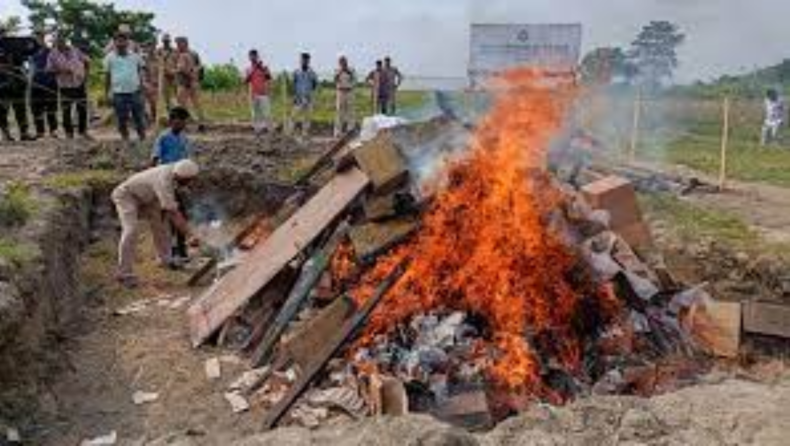In the virtual presence of Union Home Minister Amit Shah, the Narcotics Control Bureau (NCB) destroys 30K Kg of drugs on July 30 at four locations: Kolkata, Chennai, Delhi, and Guwahati. As part of the “Azadi Ka Amrit Mahotsav,” a drug disposal program that started on June 1 destroyed the illegal drugs.
NCB Destroys 30K Kg of Drugs were destroyed on Saturday in Delhi (19,320 kg), Chennai (13,09 kg), Guwahati (6,761 kg), and Kolkata (3,077 kg). At the seminar in Chandigarh, Shah said that the national government’s zero-tolerance approach to drugs was working.

He claimed that doing this is essential to achieving the goal of a prosperous nation rich in phosphorous. From a security standpoint, according to Shah, it is also crucial since “the dirty money” created by the drug trade is utilized in actions against the nation.
“The central government had implemented a zero-tolerance policy towards drugs when Narendra Modi became Prime Minister in 2014,” Shah remarked. The NCB was in charge of planning the conference.
What laws allow for the destruction of drugs that have been seized?
Under Section 52-A of the Narcotics Drugs and Psychotropic Substances (NDPS) Act of 1985, investigating agencies are allowed to destroy drugs that have been seized once the required samples have been collected. The substance that needs to be eliminated must be thoroughly inventoried by the concerned officials.
“A five-member committee is established, consisting of the local magistrate, the area SSP, the director/superintendent or the area NCB representative, and two other members with ties to the legal and law enforcement communities.
The drug is subsequently burned totally or destroyed in an incinerator, leaving no trace left, according to Advocate Kailesh, the Chandigarh counsel for NCB.
What particular steps are taken in this process?
Before disposing of the seized drugs, the agency first gets the go-ahead from a local court. The specified location for the destruction of these chemicals is then visited with extreme vigilance. With the material brought to the location, the presiding officer adds up the inventory made at the storeroom. Both video and photos are taken of the entire process.
Then each package or gunny bag containing the chemical is placed one at a time into the incinerator. It is against the rules for committee members to leave until all of the drugs that were confiscated have been destroyed.
Which organization has the right to conduct such an exercise?
Every law enforcement agency with the ability to seize drugs is allowed to destroy them with the local magistrate’s prior approval. State police departments, the CBI, and the NCB are a few examples of these.
On June 20, 102.260 kilograms of heroin, 0.495 kilograms of charas, 0.250 kilograms of poppy husks, 16.6 kilograms of cannabis, 48 injections of buprenorphine, and pheniramine maleate, and 904 tramadol tablets were destroyed in Mohali by Chandigarh Police and NCB sleuths.
Why do we need to destroy drugs that have been seized?
Narcotic drugs and psychotropic substances are dangerous, and authorities destroy them for a variety of reasons, including their susceptibility to theft and substitution and the lack of appropriate storage space.
There have been cases where stolen drugs from the warehouse were seized drugs. Authorities attempt to destroy drugs that have been seized as soon as the necessary samples have been taken from the seized substances to prevent such incidents, the officer stated.
Way forward-
It is simple to enter the drug world and become an addict, but leaving it is difficult and requires help from those who maintain common sense. Drug addicts require timely treatment, which includes meetings with qualified counselors.
An intensive approach, like as those found in patient programs, can be a very effective way to stop relapses from substance use disorder (SUD) or drug addiction and provide sufferers the tools they need to take control of their behavior for a bright future.













